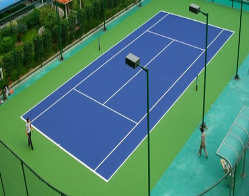The elasticity of plastic sports fields is mainly achieved through their material properties and special structure.
From a material perspective, plastic stadium materials are generally composed of high molecular weight materials such as polyurethane (PU). Polyurethane materials themselves have good elasticity. There are certain flexible connections between the molecular chains of these high molecular polymers, and when subjected to external forces, the molecular chains can stretch and deform to a certain extent. For example, like small elastic springs, when an athlete steps on the field, these molecular chains are compressed and store energy. After the external force disappears, the molecular chains will return to their original state, releasing the stored energy and causing elastic deformation and recovery on the surface of the stadium.

At the same time, some rubber particles will be added to the formula of plastic materials. These rubber particles can further enhance elasticity. Rubber particles are like tiny elastic balls, distributed within the plastic material. When pressure is applied to the field, rubber particles will be squeezed and deformed, playing a buffering role. Moreover, the interaction between these particles and the plastic matrix makes the elasticity of the entire stadium more uniform and durable.
From a structural perspective, the elasticity of plastic sports fields is also related to their installation method. During the construction process, plastic materials are usually laid in layers. The bottom layer material mainly plays a supporting and stabilizing role, while the surface layer material focuses more on properties such as elasticity and friction. This layered structure allows the stadium to better withstand forces of different directions and sizes. For example, when an athlete jumps and lands, the impact force is first absorbed and dispersed by the elastic material on the surface, and the remaining force is then transmitted to the lower layer. The lower layer material further buffers the impact force through its own toughness and stability, avoiding damage to the surface of the field due to excessive local force, while also ensuring effective elasticity.
In addition, some high-quality plastic courts also consider the needs of different sports events when designing. For example, for sports such as basketball and tennis that require frequent jumps and sudden stops, the elasticity of the court will be designed to be more moderate to provide a good sports experience while reducing the risk of athlete injuries.




